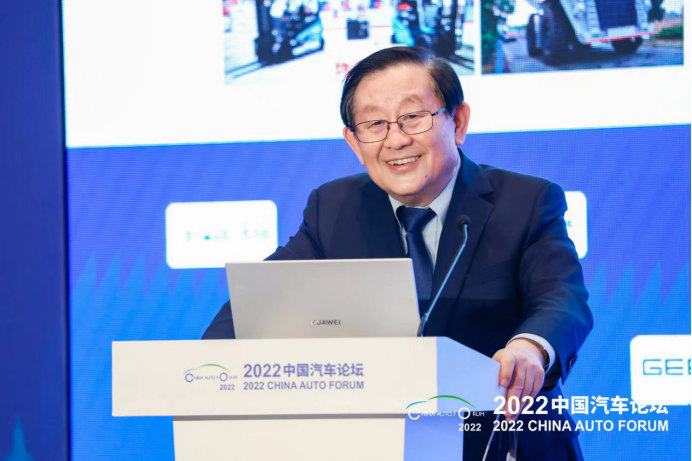Author: Lingfang Wang
Editor: Kaijun Qiu
At the 12th China Auto Forum on November 9th, the Vice Chairman of the National Committee of the Chinese People’s Political Consultative Conference and the President of the China Association for Science and Technology, Gang Wan, stated that “by 2035, it will not be a problem for new energy vehicles to account for more than 50% of new car sales. However, we still face many challenges such as imbalanced regional development of new energy vehicles, slow progress of commercial vehicle electrification, etc.”
In Wan’s view, by September 2022, China’s total sales of new energy vehicles will exceed 13.5 million, with outstanding development achievements and significant effects: the technology level of new energy vehicles and key components has been comprehensively improved, and customer demand has been basically met. However, at the same time, there are still many challenges such as imbalanced regional development of new energy vehicles, the inability of the supply chain to keep up, slow progress of commercial vehicle electrification, insufficient energy supply network, and relatively backward infrastructure such as vehicle-road coordination.
Wan also proposed directions and recommendations for further development of the new energy vehicle industry.
New challenges in accelerating development
According to Wan, the development of new energy vehicles still faces many challenges.
First, there is imbalanced regional development. Putting promotion and application volumes on the map, it can be clearly seen that the promotion and application of new energy vehicles are mainly concentrated in the east and south, while the vast northeast, central, and especially northwest regions have low sales and usage rates.
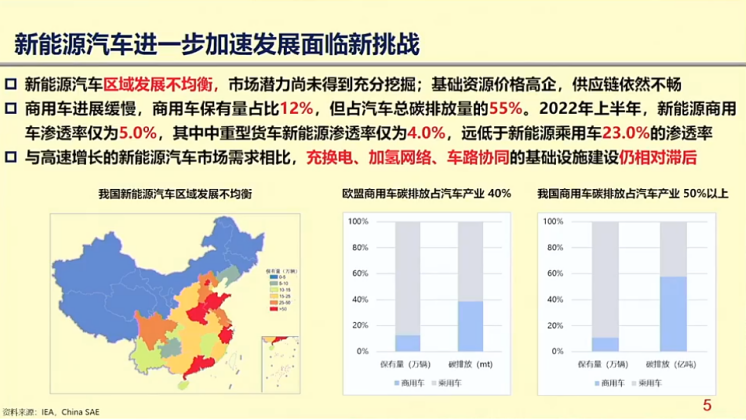
Although new energy vehicles are developing rapidly, they still do not meet the demands of people, especially in the vast areas of the northeast and northwest, which together account for more than 60% of China’s land area. In other words, “China still lacks half of the new energy vehicle market in terms of application, which is a new research topic worthy of attention.”
Second, there is a supply chain problem. Although the chip shortage problem has been alleviated to some extent since last year, the supply chain still cannot keep up. This is due not only to external pressures, but also to the need to stimulate internal growth in the domestic market.
Third, there is slow progress in commercial vehicle electrification. Wan believes that to achieve the “dual-carbon goal” in the automobile industry, one must consider who contributes the most to carbon emissions in automobiles. Although commercial vehicles only account for about 12% of the vehicle holding quantity, their emissions account for 55% of the automobile field. In other words, even if the passenger vehicle field makes great efforts, it still lacks half of the required reduction to achieve the “dual-carbon goal”.In the first half of 2022, the penetration rate of commercial vehicles in China was 5%, among which the penetration rate of new energy commercial vehicles, especially medium and heavy duty trucks, was only 4.0%, far lower than the 23.0% penetration rate of new energy passenger cars.
Moreover, compared with the rapidly growing market demand for new energy vehicles, the infrastructure construction of charging, swapping, hydrogen refuelling, and vehicle-road cooperation still lags behind.
New situation of development
In the new situation of new energy vehicle development, Wan Gang mainly mentioned four aspects: 1. Development direction of battery technology; 2. Efficiency of internal combustion engine-electric drive system; 3. Electric transformation of commercial vehicles focusing on fuel cell; 4. Cross-border integration.
(1) The continuous strengthening of core technology development of new energy vehicles is required.
Wan Gang believes that the overall technology level of new energy vehicles and key components has been improved, which basically meets the current customers’ needs.
However, it is necessary to further improve the adaptability, safety, and economy of pure electric vehicles, especially to solve the problem of the northwest region’s environmental adaptability.
This year, the export sales volume of cars is good, indicating that the overseas market for new energy vehicles is very broad in the future. Especially in the face of the huge changes caused by the war between Russia and Ukraine and the energy crisis, people all over the world know that the price of traditional energy is unstable, and the possibility of continuous and even double price increases is very high, which shows the enormous potential of the new energy vehicle market.
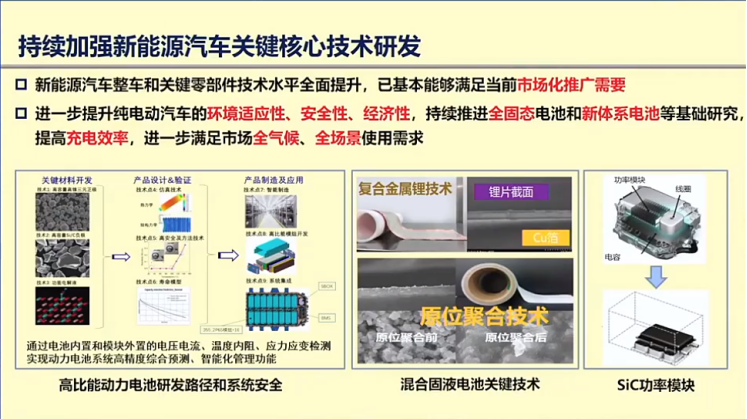
In terms of batteries, Wan Gang believes that the future development direction is from the hybrid solid-liquid battery to the all-solid-state battery, as seen in Japan. Wan Gang suggests that the industry should continue to promote fundamental research such as all-solid-state batteries and new system batteries, improve charging efficiency, and further meet the market’s all-weather and all-scenario usage needs.
(2) Coordinated promotion of the efficiency of internal combustion engine-electric drive system
Wan Gang said that the production capacity of more than 27 million vehicles with internal combustion engines should also be brought to the track of new energy vehicles. Therefore, the coordinated promotion of internal combustion engine-electric drive system efficiency is still necessary.
In Wan Gang’s view, in the first half of 2022, the market has actually given the answer, with sales of plug-in hybrid/extended-range hybrid vehicles reaching 534,000 units, a year-on-year growth of 1.7 times, and a market penetration rate of 5.2%.
 Wang Gang affirmed the effectiveness of plug-in hybrids and range extenders. “The comprehensive fuel consumption of plug-in hybrids and range extenders is very important as it indicates their energy configuration. The comprehensive energy consumption of Chinese plug-in/extended-range vehicles is basically within 2 liters, and is now moving towards below 1 liter, with range extenders playing a significant role.”
Wang Gang affirmed the effectiveness of plug-in hybrids and range extenders. “The comprehensive fuel consumption of plug-in hybrids and range extenders is very important as it indicates their energy configuration. The comprehensive energy consumption of Chinese plug-in/extended-range vehicles is basically within 2 liters, and is now moving towards below 1 liter, with range extenders playing a significant role.”
Therefore, Wang Gang suggests that internal combustion engines should still develop, and the direction of development can be from high power density to high efficiency, which is how to find the best point of adaptation between it and the motor, so that it can generate electricity with the highest efficiency under the lowest emissions. This may be the future direction of development.
“We need to coordinate the promotion of plug-in/extended-range hybrid vehicles, improve the integration, electrification, and efficiency level of internal combustion-electric drive systems through the combination of internal combustion engine and electric drive technology, the fusion of intelligent control, and provide diversified product supply for different consumer demands, driving the transformation and upgrading of traditional power systems.”
The western and northeastern regions with low popularity of new energy are where internal combustion-electric drive systems can play a role. Wang Gang believes that although the current consumption capacity in these areas is not as good as that in the east, there is a huge potential market, and since the cities and villages in these areas are far away, consumers cannot have mileage anxiety, and the temperature difference in these areas is large, making it difficult to start vehicles in the winter. Therefore, we need to consider how to make full use of the preheating function of the internal combustion system, driving the transformation and upgrading of traditional power systems.
(3) Accelerate the transformation of fuel cell-focused commercial vehicles to electrification
Looking back at the achievements, during the Beijing Winter Olympics, with the joint support of full green hydrogen and full green electricity, more than 2,200 tons of carbon were reduced by only 1,200 fuel cell vehicles.
The four departments established a demonstration of fuel cell vehicle cities in Beijing-Tianjin-Hebei, Hebei, Henan, Shanghai, and Guangdong, forming a cross-city linkage demonstration effect. The Ministry of Science and Technology launched the “Hydrogen into Ten Thousand Households” demonstration project in Shandong Province, with Qingdao Port, Weifang Port and the intersection of the expressway as the support points. Wang Gang suggested that Shandong’s renewable energy and Shandong’s industrial by-product economy can be combined to form a comprehensive test for hydrogen-powered vehicles, hydrogen-powered ships and even storage.
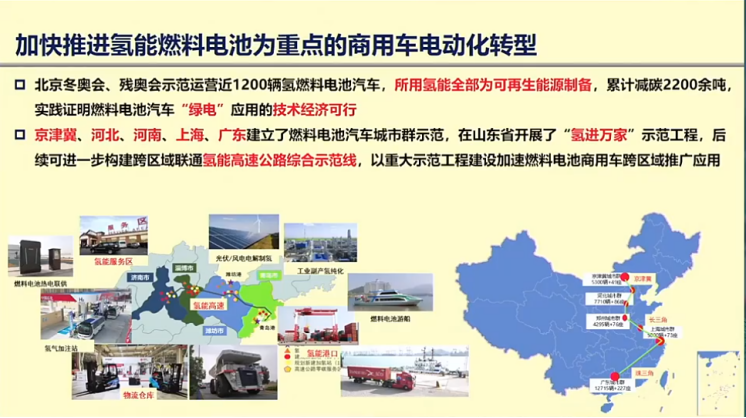 万钢 also mentioned that a cross-regional hydrogen energy high-speed comprehensive demonstration line can be further built in the future, connecting from the north to the south, and accelerating the cross-regional promotion of fuel cell commercial vehicles through the construction of major demonstration projects. “Now we can mobilize all forces, and I estimate that the highway can be opened in a year’s time.”
万钢 also mentioned that a cross-regional hydrogen energy high-speed comprehensive demonstration line can be further built in the future, connecting from the north to the south, and accelerating the cross-regional promotion of fuel cell commercial vehicles through the construction of major demonstration projects. “Now we can mobilize all forces, and I estimate that the highway can be opened in a year’s time.”
“Remember when we were promoting electric vehicles, we conducted similar promotion experiments by building charging piles on the Beijing-Shanghai Expressway and gradually expanding to other areas. I think we still need a large-scale demonstration, just like the demonstration scale of ten cities and thousands of vehicles back then, to promote it through industrial planning.” said Wan Gang.
(4) Fast Integration and Agglomeration of Industrial New Impetus for High-quality Development
At the conference, Wan Gang also mentioned the integration of automobiles and energy, as well as the integration of vehicles and roads.
The integration of “vehicle interconnection” is to effectively promote the consumption of renewable energy and improve the flexibility of the power system through the bi-directional interaction between electric vehicles and the power grid; the development of fuel cell vehicle technology can drive the multi-field application of hydrogen energy technology. Meanwhile, the “vehicle-road integration” can accelerate the landing of intelligent and networked technologies. The fusion of vehicle-road information can provide cognitive intelligence beyond the perception vision of single-vehicle intelligence, avoiding the perception limitations of single-vehicle intelligence.
The current clean energy carriers in the world’s new era are hydrogen and electricity, which are both derived from the natural environment and can be used in many driving forms.
In Wan Gang’s view, the 13 million new energy electric vehicles in China are each a small energy storage station. And this energy storage is in the distribution network, parked in the place where we need electricity most, without the need for scheduling like water pumping and power transmission.
How to promote the integration of “vehicle and energy”? Wan Gang gave an example that large cities like Shanghai can use this function to balance peak and valley electricity, and car owners can reduce their expenses or increase their income as a result.
“Vehicle-road integration” is currently the fastest advancing intelligent network. Wan Gang believes that the intelligent network in China has truly achieved the integration of vehicles and roads. Through wireless base stations scattered throughout the country, our cars can truly achieve V2X.
The first goal of intelligent networking is safety. Then, through the collaboration of car-cloud, the new generation of mobile travel system becomes a platform for industrial integration to promote the realization of multiple network integration such as transportation network, IoT, etc., forming a new market ecosystem.Wang Gang believes that to achieve true cross-border integration, the automotive industry still has a lot of work to do. In his view, today’s in-vehicle networks are actually the accumulation of the past 20 years. Previously, they were usually controlled by function, but now the network is a distributed system.
Now it needs to be used as a centralized control system, especially with the addition of new sensors in recent years, such as laser sensors, radar, and millimeter-wave sensors, which have greatly increased the amount of data and burden on the network itself. If it encounters interference from other data, false alarms often occur, which makes this basis unreliable. It is the consensus of the industry to gradually move from a distributed architecture to a domain-centralized architecture.
As a result, there will be a comprehensive transformation of operating system technology architecture, core technology, software development models, and application ecosystems. At the same time, the automotive operating system should also consider personalized needs and the integration of the external network.
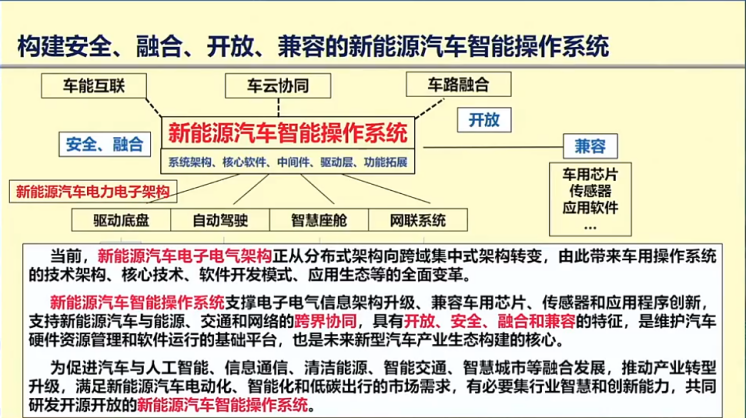
The intelligent operating system for new energy vehicles supports the upgrading of the electronic and electrical information architecture, is compatible with vehicle chips, sensors, and innovative applications, and supports cross-border collaboration between new energy vehicles and energy, transportation, and networks. It has characteristics of openness, security, integration, and compatibility. It is the basic platform for maintaining the management of automotive hardware resources and software operations, and is also the core of building the ecological environment of future new automotive industries.
“In order to promote the integrated development of automobiles and artificial intelligence, information and communication, clean energy, intelligent transportation, intelligent cities, and other fields, promote industrial transformation and upgrading, and meet the market demand for electrification, intelligence, and low-carbon travel of new energy vehicles, we need to gather industry wisdom and innovation capabilities, form a joint venture, and jointly develop an open-source and open new energy vehicle intelligent operating system.“
Nowadays, there are many large companies that have their own systems for intelligent cars. Wang Gang pointed out that we cannot just build it on the beach. We should do a good job with the underlying logic and leverage everyone’s strengths. This kind of operating system should be scalable and adaptive to multiple requirements. It should be an “unsung hero”. Therefore, we must build a jointly developed, open-source, and open new energy intelligent operating system that can continue to grow, requiring joint efforts from enterprises and striving to achieve it as soon as possible.
Need to Build a Green Low-carbon New Ecology
New energy vehicles only solve the problem of low emissions on the road, but energy supply is still not low-carbon.Wan Gang said that new energy vehicles also need to solve the problems of low-carbon energy supply, low-carbon material supply, and low-carbon production processes, and promote carbon neutrality throughout the industry and the entire lifecycle.
Wan Gang explained the importance of carbon neutrality throughout the industry. “We are now the world’s second-largest exporter. If we do not do well in carbon production and carbon neutrality, not only will our business be affected, but carbon taxes may be imposed one day. Therefore, comprehensive carbon neutrality throughout the industry chain and the entire lifecycle has become the current goal of joint efforts across various industries.“
Wan Gang believes that there is a need to innovate the extraction and refining technology of battery materials, manage the trading of lithium, nickel, and cobalt commodities, and ensure industrial safety and stability.
He suggested that batteries can be removed and used for 5G base stations, which then gradually formed an industry chain, including production, hierarchical use, retirement, reuse, and full recycling.
“The industry should jointly explore and promote the low-carbon standards and management systems of key parts products such as complete vehicles and power batteries, and promote the interoperability, mutual recognition, and sharing of carbon emission accounting methods and basic data. Strengthen the cooperation, dialogue, and exchange of global automotive industries in the fields of carbon emission management and carbon emission reduction incentives, and form an international collaborative mechanism for low-carbon management of fair, scientific, and transparent principles in international automotive trade.”
Wan Gang suggested that all enterprises jointly promote the digital, intelligent, and low-carbon development of the entire lifecycle of automobile product research and development, production, and recycling, and promote the green and low-carbon sustainable development of the global automotive industry chain.
“In Wan Gang’s view, China’s new energy vehicle industry has entered a new stage and urgently needs all parties in the industry chain to continue to strengthen research on key, core, and foundational technologies of new energy vehicles, and promote the coordinated development of internal-combustion and electric power drive. Accelerate the cross-regional promotion of fuel cell commercial vehicles, promote cross-border integration through connectivity of vehicles, roads, and the cloud, and promote industry upgrading through green and low-carbon development, focusing on high-quality development and expanding high-level openness, and promote the new energy vehicle industry towards electric, intelligent, and low-carbon sustainable development new journey.”# Markdown 中文文本
这是一段包含 粗体 和 斜体 的文本。
这是一个有序列表:
- 第一项
- 第二项
- 第三项
这是一个无序列表:
- 第一项
- 第二项
- 第三项
这是一段代码:
<!DOCTYPE html>
<html>
<head>
<title>示例</title>
</head>
<body>
<h1>这是一个标题</h1>
<p>这是一个段落。</p>
</body>
</html>
这是一个链接。
这是一个图片:

完成!
This article is a translation by ChatGPT of a Chinese report from 42HOW. If you have any questions about it, please email bd@42how.com.
